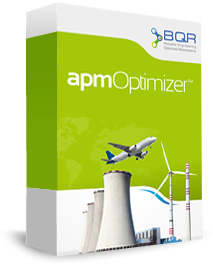Deciding if Software is Right For Your Program
 Let’s face it, the field of reliability engineering is diverse and full of statistics, models and detailed analysis. The detailed calculations, the building of models and analysis, have been performed with great success in the past and currently. The models built through manual calculation have been successful and demonstrated the importance of reliability engineering.
Let’s face it, the field of reliability engineering is diverse and full of statistics, models and detailed analysis. The detailed calculations, the building of models and analysis, have been performed with great success in the past and currently. The models built through manual calculation have been successful and demonstrated the importance of reliability engineering.
In today’s environment where multiple models may be required for slight variants of a design or maintenance strategy, the manual calculations can be extremely time-consuming, and also open up the opportunity for errors. Not to mention the short time to market or the need for repeatability and traceability of an analysis. Minor errors in the reliability analysis can lead to excess downtime, excess spare parts, or excessive life cycle cost.
Today’s reliability engineers need to be able to make accurate and timely recommendations and variations trading off time, cost or performance. To facilitate the development of the models, and perform the advanced calculations, a reliability engineering software package can assist (it is not required). As with most software, this specialized software is a tool and must be used correctly. That means knowing when and how to use it. Also, there is not one specific software package for all applications.
As with all tools, there are unique disadvantages and advantages to them. Specialized reliability engineering software is no different. The advantages and disadvantages of the software must be carefully considered before a decision is made to use a reliability engineering software package.
Disadvantages of Reliability Engineering Software
Let’s start off with the disadvantages to using the software. Yes, there are disadvantages, and they are important to be aware of. While not exhaustive (and are my opinion), the disadvantages should cause anyone using or buying the software to pause and review their needs or practices;
- The outcomes still need to be checked and validated for accuracy, especially in safety critical situations. Incorrect data input can lead to significant inaccuracies in the output.
- Outputs from various software packages can provide different results. This is usually due to the way that the calculations are performed and models analyzed in the software.
- Cost can be an issue depending upon what the software will be used for. In most industrial or commercial applications, the software can be justified, but such specialized software does not come free.
I struggled to place this last point, as it is not really a disadvantage but a word of caution;
- A reliability engineer is still required to perform the analysis and review the findings. Not any individual can use the software and expect accurate, repeatable results. So if you don’t have knowledgeable staff using the software, I would question the results you are getting.
If you have any other disadvantages, please comment below and share them with the wider group.
Advantages of Reliability Engineering Software
Now, on to some of the advantages to using the software. Once again this list is not exhaustive (and are my opinion);
- A source of manual errors in some models and calculations is the rounding of numbers. This is known as rounding errors and occurs when the analyst decides to round the decimal places after a certain number of places. This type of error is generally not a concern when using specialized software packages.
- Ability to run multiple models quickly. Typically the software enables the analyst to make a few changes or variants, run the different models and provide a review of all the different models. This enables the analyst to provide different scenarios balancing cost, risk, and performance.
- Model Based System Engineering (MBSE). MBSE means one system model that all involved parties can access. Specialized software can help to present a clear picture of asset hierarchies, failure causes and effects, and related logistics and maintenance policies.
- The software’s role is to facilitate the reliability engineers, make their job easier and faster, and to support data-driven decision making. This allows them to dive deeper into issues, or address more issues.
If you have any other advantages, please comment below and share them with the wider group.
To Software or Not Software
Many reliability engineers perform their analysis is Excel. This software package is excellent and provides a cost effective approach to most basic statistical problems, analysis, and models. However, Excel requires extensive knowledge of both Excel and statistics to make it work, and it is easy to introduce errors. But Excel is better than nothing, and I have used it extensively. As the old saying goes “If all you have is a hammer, then everything looks like a nail.” So make sure that your reliability engineers toolbox has the right tools in it.
For those that have reliability engineering software, what were the critical decision factors that caused you to purchase a software package? What learnings could you share with your fellow readers? For those that don’t yet have a reliability engineering software package, I would highly encourage you to check out BQR‘s packages to see if they are right for you;
- Fixtress is a comprehensive Design for Reliability (DfR) suite comprising three software tools that accelerate and optimize the design process. fiXtress is the only tool that integrates design error detection with stress, thermal and service life prediction on the schematic-level, before PCB layout.
fiXtress enables you to design highly effective, reliable and innovative systems, shortening time-to-market, improving reliability and reducing failure and malfunction. - CARE comprises an integrated set of software tools, offering engineers a complete solution for all RAMS (Reliability, Maintainability, Availability, and Safety) aspects of a product. CARE analyzes various components failures and their impact on system operational behavior and safety while taking into account redundancy and backup elements. Unlike other tools, CARE provides all reliability analysis in one integrated platform – including traditional Mil-Std, ISO 9000, EN and IEC standards methods and advanced RAMS & ILS analysis techniques. The use of BQR CARE improves and enhances product reliability and robustness.
- APMOptimizer is a unique maintenance optimization tool that enables engineers to model the existing asset maintenance concept and run an optimization process that recommends new cost saving maintenance policies.
Whether you are designing circuits, performing FMECAs, or having to optimize spare holding and maintenance strategies, BQR’s software can handle many of the reliability tasks. If you are interested in seeing a demo of the different packages from BQR, please contact [email protected].
Remember, to find success; you must first solve the problem, then achieve the implementation of the solution, and finally sustain winning results.
I’m James Kovacevic
Eruditio, LLC
Where Education Meets Application
Follow @EruditioLLC
References:


Another benefit of modelling using software applications is to define a clear business case for the selection of a specific maintenance strategy ie a condition based task and a corrective task. The application can (usually) define the financial benefit of one strategy over the other possibilities.